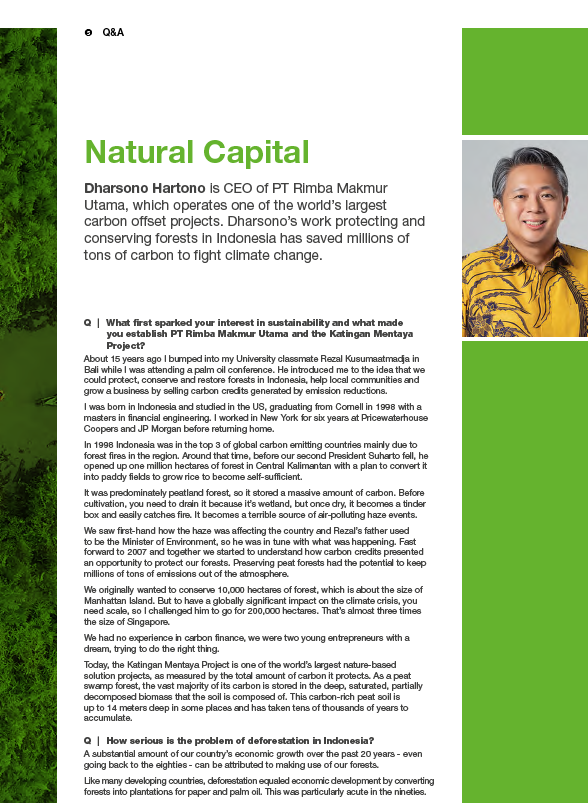-
In 1998 Indonesia was in the top 3 of global carbon emitting countries mainly due to forest fires in the region
-
The Katingan project protects habitats for five critically endangered, eight endangered and 31 vulnerable species
-
The carbon credit market is maturing, we see the necessary apparatus put in place to help ensure credibility and mitigate risk
What sparked your interest in sustainability and what made you establish PT Rimba Makmur Utama and the Katingan Mentaya Project?
About 15 years ago I bumped into my University classmate Rezal Kusumaatmadja in Bali while I was attending a palm oil conference. He introduced me to the idea that we could protect, conserve and restore forests in Indonesia, help local communities and grow a business by selling carbon credits generated by emission reductions.
Before our second President Suharto fell, he opened up one million hectares of forest in Central Kalimantan with a plan to convert it into paddy fields to grow rice to become self-sufficient.
It was predominately peatland forest, so it stored a massive amount of carbon. Before cultivation, you need to drain it because it’s wetland, but once dry, it becomes a tinder box and easily catches fire. It becomes a terrible source of air-polluting haze events.
Fast forward to 2007 and together we started to understand how carbon credits presented an opportunity to protect our forests. Preserving peat forests had the potential to keep millions of tons of emissions out of the atmosphere.
We originally wanted to conserve 10,000 hectares of forest, which is about the size of Manhattan Island. But to have a globally significant impact on the climate crisis, you need scale, so I challenged him to go for 200,000 hectares. That’s almost three times the size of Singapore.
Today, the Katingan Mentaya Project is one of the world’s largest nature-based solution projects, as measured by the total amount of carbon it protects. As a peat swamp forest, the vast majority of its carbon is stored in the deep, saturated, partially decomposed biomass that the soil is composed of. This carbon-rich peat soil is up to 14 meters deep in some places and has taken tens of thousands of years to accumulate.
How serious is the problem of deforestation in Indonesia?
A substantial amount of our country’s economic growth over the past 20 years – even going back to the eighties - can be attributed to making use of our forests. Like many developing countries, deforestation equaled economic development by converting forests into plantations for paper and palm oil.
Over the past decade, Indonesia has begun doing a much better job of controlling deforestation, but illegal logging is still a problem.
The government has stopped issuing licenses to palm oil producers especially for designated areas like ours. But there are still significant threats that requires active conservation to mitigate.
What magnitude of emissions have you saved so far and what are your goals?
Over the past 10 years we have issued close to 40 million carbon credits. Each credit represents a unique, real, measurable ton of carbon dioxide that has been prevented from being released into the atmosphere and further contributing towards climate change.
In Indonesia you cannot purchase land so we were granted a 60-year concession from the government in 2013 for which we pay an annual fee. This land generates on average about 7 million tons of carbon credits annually, which is equivalent to taking 2 million combustion-engine cars off the streets.
Conservation helps restore balance between biodiversity and humanity. The project protects habitats for five critically endangered, eight endangered and 31 vulnerable species. The protected area is home to between 5% and 10% of the global populations of the Bornean Orangutan, Proboscis Monkey and Southern Bornean Gibbon.
How challenging is it to make it profitable and what are the barriers?
It is absolutely crucial that conservation actions like ours are profitable. If we want to combat the climate crisis and reverse the decline of biodiversity, then protecting the natural world must be taken seriously, it must viable and there needs to be income.
After 15 years, we are profitable. We have more than 200 full-time staff and employ another 400 to 500 part-time staff during the dry season to patrol and help in the fire mitigation efforts.
When we started out, there were no large-scale forestry projects out there and at that time there was no certainty in the market. But things have changed a lot, especially in the last four or five years. Today there is substantial growth in demand from corporates with ambitious climate targets and scientifically robust strategies to meeting them.
Despite the advances, there are still challenges to overcome.
One frequently cited concern is the counterfactual an avoided deforestation project is based on. Opponents of our model will argue that we can never be sure that our modelled deforestation scenario will have happened or that it can be exaggerated to increase the value of the project. Aside from the fact that counterfactuals are an important function of scientific modelling, this argument fails to grasp the level of assurance that is required for a project to meet third-party standards. For an avoided planned deforestation project, like the Katingan Mentaya Project, we have demonstrated clear science-based evidence to show the extent of deforestation that would happen without our intervention.
All of our credits are verified against Verra, the world’s leading carbon standard setter. The project is further validated to the Climate, Community and Biodiversity Standards (a partnership of nongovernmental organizations, corporations and research institutes), for which we have achieved the highest rating, Triple Gold.
Are wildfires becoming more of a challenge as the planet heats up?
Every year during the dry season we see wildfires break out across the region. The 2019 season caused extensive damage in Kalimantan.
We have 200 people monitoring if wildfires are approaching. We use satellites and drone technology in near real-time to assist our teams. Our fire mitigation effort is community-based so we work with the villages to do the patrolling.
We also work inclusively with communities to discourage them from adopting practices such as ‘slash and burn’. We help them to be more productive farmers and fishermen to protect this fragile ecosystem.
And as a final precaution, all voluntary carbon projects must submit a percentage of credits each year to a buffer pool as an insurance mechanism. This means that for whatever reason we experience damage to the forest area, the carbon credits already issued are still valid.
The voluntary carbon market has taken a while to hit $2 billion. Do you think it’s set to take off given the number of companies that are coming out with net zero commitments?
Our buyers provide a good insight into this question. They range from energy, to financial firms, auto manufacturers like Volkswagen, and airlines like Delta.
We are well placed as every company is looking to fulfil its net zero commitments and heavy emitting industries will probably have to buy more than other sectors.
But we also need to educate buyers that what they’re buying has real impact. We are still missing that part.If greenwashing concerns arise then it can cause difficulties for project developers.
A recent analysis from the rating agency Sylvera, found that companies buying carbon credits reduced their emissions twice as fast as those that do not buy carbon credits. That’s a welcome sign that some firms are pulling every lever available in the fight against climate change.
Carbon offsets play an important role in eliminating residual emissions yet they often come in for criticism. why do you think that is?
The voluntary carbon market is not perfect and some forest projects are underperforming. It is right that these are called out. But where I see a problem, especially with the articles published by the Guardian and others earlier this year highlighting some of the questionable projects, is the inference that the whole sector is bad.
I’m worried that for some parts of the media, there is a prevailing bias against the use of offsets or private sector involvement in activities like conservation. The first wave of ‘wild west’ offsets and experiments with REDD+ that started 20-25 years ago had a lot of problems, but today the landscape is entirely different. We have internationally recognized standards that are based on the latest scientific understanding and undergo thorough peer review. We have public registries, independent ratings agencies and increasing levels of scrutiny.
For a corporation looking to meet its own climate targets, if it uses third-party validated high-quality carbon credits and when this is done alongside other science-based emissions lowering activities, this is a proven, measurable and impactful climate strategy.
Disclaimer
This content has been prepared by Nomura solely for information purposes, and is not an offer to buy or sell or provide (as the case may be) or a solicitation of an offer to buy or sell or enter into any agreement with respect to any security, product, service (including but not limited to investment advisory services) or investment. The opinions expressed in the content do not constitute investment advice and independent advice should be sought where appropriate.The content contains general information only and does not take into account the individual objectives, financial situation or needs of a person. All information, opinions and estimates expressed in the content are current as of the date of publication, are subject to change without notice, and may become outdated over time. To the extent that any materials or investment services on or referred to in the content are construed to be regulated activities under the local laws of any jurisdiction and are made available to persons resident in such jurisdiction, they shall only be made available through appropriately licenced Nomura entities in that jurisdiction or otherwise through Nomura entities that are exempt from applicable licensing and regulatory requirements in that jurisdiction. For more information please go to https://www.nomuraholdings.com/policy/terms.html.





